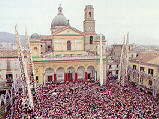NOLA

Feast of Lilies
Nola, which is of Auson origin, passed in the possess of Sanniti at the end of the V century, absorbed Hellenic culture and customs, as it prove the precious vases found in the necropolis.
Nola, allied with Rome after the second Sannitic war, was one of the principal bases of Roman operations against Annibal. It was conquered by Silla in the 79 B.C., who used a group of veterans. In Nola died Augustus in the 14 A.D.
After have been destroyed by the Vandals in the 455 A.D. and then by Saraceni and Hungarian, it was transformed in county by the Angevin, it was feud of the Monfort, before, and of the Orsini, after.
In the 1528 it returned to the state property and followed, from that moment, the fates of the Kingdom of Naples.
There had beginning, with the military pronouncement of Morelli and Silvati, the Italian Risorgimental revolts. Nola is famous specially because here has been, from the 409 A.D., the Episcopal seat of San Paolino, that introduced the custom of the bells in the church named "nolae".
During the feast celebrated in honour of the Saint, the Sunday following the 22nd of June, eight spires, the Lilies and a wooden-papier mache’ boat are leaded in procession along the streets of the city. This is to remember the triumphal reception that Nola made for its Bishop when he returned from Africa, where he had gone to ransom the son of a widow from the slavery of the Vandals.


